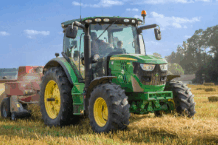Enjoy your barbecue with family and friends this July 4; it will probably be the last one you will see under $100 for 10 people for the foreseeable future.
That was the conclusion of a panel of commodity experts from RaboBank, who presented their traditional annual “barbecue index” June 26 as an informal way of assessing prices and consumer behavior. The RaboBank team assumed a guest list of 10 people and analyzed prices for beverages, beef, buns, chicken, cheese, potatoes, lettuce and tomatoes, with avocados included this year. Pickles and corn were not included. The team calculated the total cost at $99.
While overall inflation is back to something like normal, said Tom Bailey, senior analyst of consumer foods, “the devil is in the details” for consumers. While financial markets and the stock market are doing well, ordinary consumers are disconnected from that success and continue to be squeezed by higher food prices. Average wages have risen 29% since 2019, but food prices have risen by 30%. “Food prices are as good as they are going to get for some time,” he concluded. Consumer sentiment is slightly improving in recent months, but consumers “have thrown in the white flag.”
Consumers now have to work nine hours for that 10-person barbecue, an 8.32% increase from 2019. It is five times more expensive to eat out than at home. Demand for food services is down, while value groceries are doing well; Aldi revenues are up 14% in the past year. Food service still makes up 56% of total consumer food spending, with groceries at 44%, but “a shift is coming,” Bailey said.
The total cost of the hypothetical barbecue was up by 2% from last year, and up by 29% from 2019. Beer made up the single biggest portion of the barbecue expense, at 40% of the total cost, with beef making up 14%. Chicken prices actually went down 3% from the same time last year, and lettuce was down 2%. Ground beef was up 4%, and white bread or buns were up by 1.7%.
Beef trends
Senior beef analysis Lance Zimmerman discussed the multi-year cycling behind beef prices. Cow herds have been trending steadily downward since 1994, due to a variety of factors, including input costs of production, geopolitical trends, drought, the COVID lockdowns and supply chain whipsaws and the woes of restaurants. Now the move is to install “slow but consistent incentives to rebuild herds,” Zimmerman said.
In the last 12 months, beef supplies have been relatively steady, with prices kept high by expanding domestic demand. One reason is an increase in carcass weights, by 30%, as producers feed cows longer. Beef exports have also declined, partly due to increased demand and partly to the strong U.S. dollar. Finally, an increase in beef imports from Canada, Australia, Peru and Brazil have contributed to a 3 to 4% increase in per capita beef supply for April.
U.S. consumers are enjoying the highest-quality beef ever, Zimmerman said, with growth in demand for many premium cuts. Although consumers have to work more hours for a pound of beef, prices are nowhere near the pain points of 2014, he said. Beef is still a good value overall, and more of the beef dollar is finding its way to the farmgate.
Beef culling down
In response to a question about the H5N1 virus, the RaboBank team said that while H5N1 is highly pathogenic to bird populations, it is considered lowly pathogenic in cattle and humans alike. Cowherd liquidation in both beef and milk cow populations is actually down throughout 2024. The year-to-date culling rate for the U.S. beef cow herd is at 10.1%, compared to 11.4% last year. The U.S. milk cow culling rate is at 30.2% compared to 34.6% in that same period last year.
Animal protein analyst Christine McCracken added that chicken and pork remain good options for the grill. Beef is three times the price of chicken per pound, and pork is twice the per-pound price of chicken. She said retail chicken promotions were up this year.
Dairy trends
The overall dairy Consumer Price Index is lower than at this time last year, but prices have risen for many dairy products, said dairy analyst Lucas Fuess. Fluid milk prices are lower, but prices for cheese and ice cream are slightly higher than last year.
Weaker cheddar output and exports have elevated cheese prices, and increasing domestic demand for butter—which is used to make ice cream—has driven up ice cream prices. Ice cream is also losing market share to other frozen treats as competition picks up in the frozen treat sector. “Ice cream doesn’t always win” in competition with other frozen treats, he said.
Generational shift in beer?
Beverage analyst Jim Watson noted beer’s weak market position, as he said beer volumes are not responding to the lower prices of the past 18 months.
“The beer industry has structural problems,” he said. Beermakers are still trying to clear a massive inventory overhang from the COVID lockdowns. Persistent price increases going back about 15 years have separated beer trend lines from those of wine and spirits. This has led to a “generational difference” in how beer is viewed by emerging consumers. Brands matter, however; the two most popular imported beers, Modelo and Corona, continue to enjoy solid numbers.



